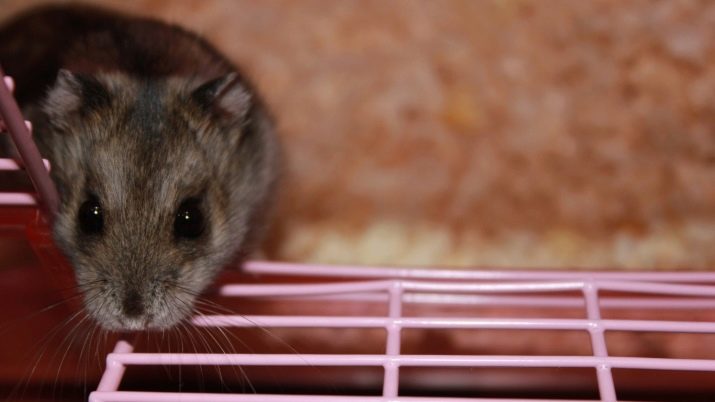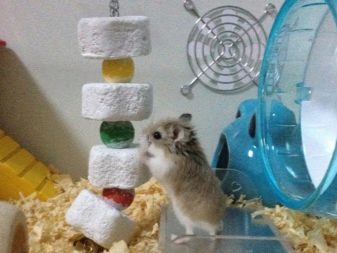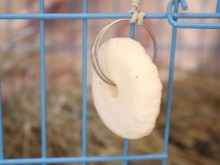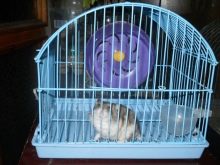If you decide to get a hamster, then it is possible that in the near future you will encounter the fact that he will begin to bite the cage. It is worthwhile to consider in more detail why the hamster bites the cage, how to wean it from it, and also what recommendations from specialists should be followed.

Causes
Hamsters in the wild feel great because they don’t have time to get bored. They are engaged in food searches, digging holes, hunting. Their life is quite interesting and moving.
If the hamster lives at home, then accordingly he does not perform all the above actions, since everything turns out like that.

Nature conceived that the hamster’s teeth grow throughout his life, so at home the pet can begin to gnaw at the bars of the cage. It is worthwhile to examine in more detail the reasons why a hamster bites a cage.
- Tooth grinding Since the teeth of the animal are constantly growing, he thus grinds them down. This usually happens at night. Since there are no branches of fruit trees or mineral stones nearby, he begins to gnaw everything that is nearby, including the rods of a metal cage, creating a big noise for those around him.
- Boredom. As the rodent becomes fenced off from carrying out the usual actions carried out in the wild, it begins to get bored - for this reason it gnaws at the cage.
- Hunger. Lack of food is also one of the reasons that the animal began to gnaw at the cage. Do not forget about your pet, monitor its diet.
- Little sleeps during the day. Since hamsters are nocturnal residents, they sleep during the day. If you prevent the rodent during the day, you can expect that at night he will behave inappropriately.
- A small cell. If the hamster is crowded, then he can show his protest by the fact that he will begin to gnaw the rods. Thus, he wants to leave uncomfortable housing.

Effects
If the hamster does not do any harm to his health while he gnaws at the cage, you should not particularly focus on this. Obviously, he just likes the process itself - not only busy, but also the noise it makes. Usually this weakness affects baby rodents. After 6 months, they should lose interest in their cell. It is worth knowing that the consequences can be quite serious. The animal can not only break its teeth against metal bars, but even rub its nose quite hard, sometimes even to the point of blood.

How to wean?
If your pet began to nibble its cage at night, then it is worthwhile to be prepared for weaning it from this action is almost unrealistic. Nevertheless, it is worth a try, because experts offer various ways.
- It is worth focusing on replacing the object that nibbles the hamster. Grass and vegetables, as well as hard foods, should be added to the animal’s food, with their help he will be able to grind them. The constant growth of teeth can not only harm the animal, for example, injure the mouth, but also lead to its death. If the situation is already very running, you should seek help from a specialist who will shorten them. But this method is already emergency, it is worth moving on to it if other options have not yielded results.
- Pay attention to the rodent's food. It should include all the necessary vitamins and minerals. It is worth adding mineral stone, as well as tree branches. With little financial cost, your hamster will get a lot of benefits and forget that you can nibble the cage.
- If the animal feels a large amount of energy, while it does not direct in the right direction, then he may be interested in his cell. The solution to this problem is to increase the load. It is enough to present the rodent with new apartments, more spacious. You can complement the cage with various accessories. A great choice would be a wheel or a running ball.


Important! Experts advise combining several methods so that the animal’s interest in the cage disappears.
For example, you can treat your hamster with your favorite treat and put a wheel for running. This will save you from noise, the hamster will be able to keep fit, thereby strengthening the immune system.
It is worthwhile to consider in more detail the most common methods.
- Favorite treat. Today on sale a wide selection of treats for rodents. You can treat your pet not only with chips, but also with dried fruits. It is better to give preference to something solid so that the animal can grind its teeth. Treat yourself once a day at bedtime. Thus, you can enjoy the dream, and the animal will be busy with their own affairs.
- Mineral stone - This is a very useful device, because it includes both vitamins and beneficial elements. In appearance, it is no different from ordinary stone. Such a stone can be purchased at a pet store, while it is enough for a long period. To make it easier for a hamster to nibble it, the stone should be fixed on the cage wall or on a twig.
- Sprigs of various trees. They can be prepared on their own, while you should pay attention that they should not contain harmful resins, since they are toxic to animals. Prepare small branches, carefully cut off all the protruding and prickly parts to protect the hamster from possible injury. Branches should be fixed in a cage. It is necessary to monitor them in order to timely replace them with new ones, then your pet will always have an interesting lesson.
- Some experts advise using an unpleasant substance, to discourage the animal from eating the bars of the cage. But it is strictly forbidden to use chemical solutions that can lead to the death of the animal.The best choice would be lemon juice or red pepper. If the baby understands that the cell is tasteless, then soon the desire will disappear by itself.
- You can deal with the situation with a special spray, but it does not work on all hamsters. Usually sensitive persons feel its action. Its effectiveness is individual.
- It is worth paying attention to when and in what place he gnaws the rods. For example, if he takes action when he sees you with food, then he is simply hungry. If he nibbles a place near the door, then the animal wants to take a walk. It is worth fulfilling his desire - so he will stop bothering you.



Recommendations
Experts recommend following a few simple tips to wean hamster gnawing a cage.
- Usually hamsters begin to gnaw metal rods from boredom. Therefore, it is worth adding entertainment, such as toys, to his house, devote time to games, and also pick up a more spacious cage for your pet.
- If you did not notice the hamster while he was chewing on the cage, then you should pay attention to the rods - if they were previously painted, and now there is no paint in some places, then the animal chews them. If initially they were not painted, then it is worth taking a closer look or there are scratches on them or deformations.
- Try not to wake up your pet during the day, because in this way it becomes more aggressive, which can manifest itself in bites.
- During sleep, the animal’s cage can be covered with a towel, which will create comfortable conditions for relaxation.
- It is strictly forbidden to scoff at the animal - it does not need to be thrown, squeezed, shaken, because all these actions can not only be accompanied by various injuries, but also dizziness, which will negatively affect the brain.
- If the hamster runs freely, then you should carefully watch it, and also hide all sharp objects, because the animal can be injured.
- It is strictly forbidden for children to take the hamster in their hands, as they can do much harm to it. It is better if the animal is held by an adult, and the child simply strokes it.

See how to wean a hamster to nibble a cage.










